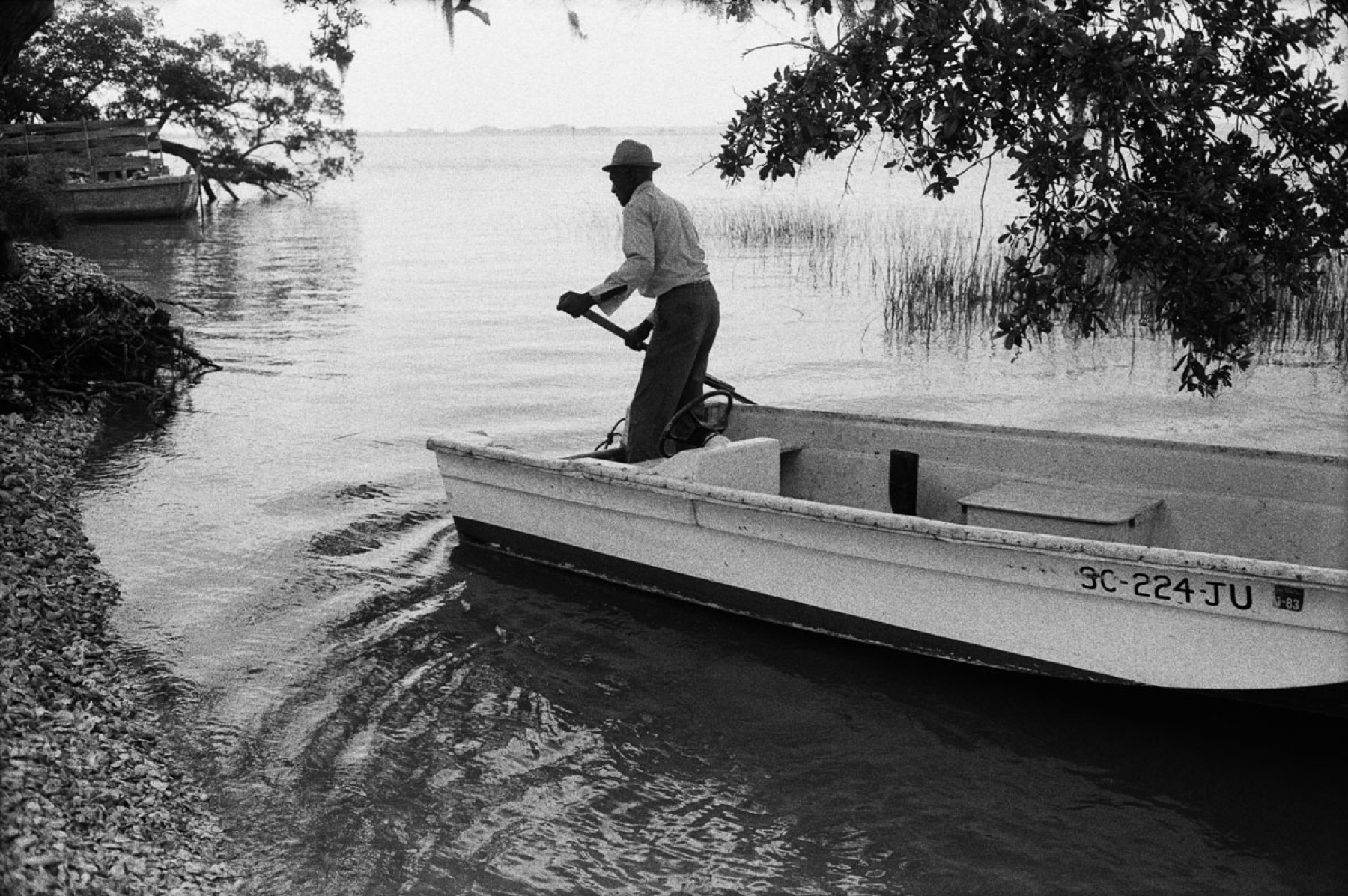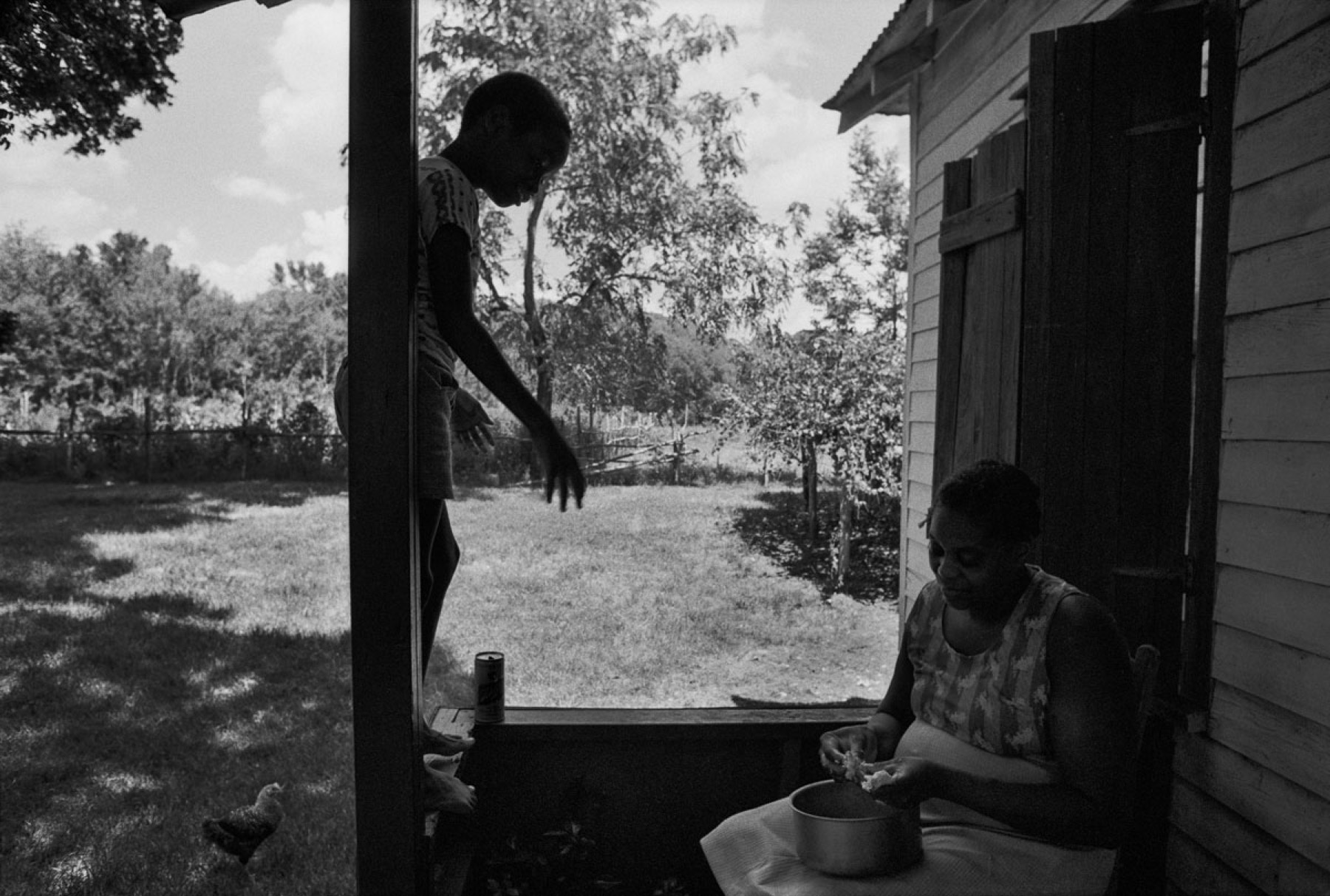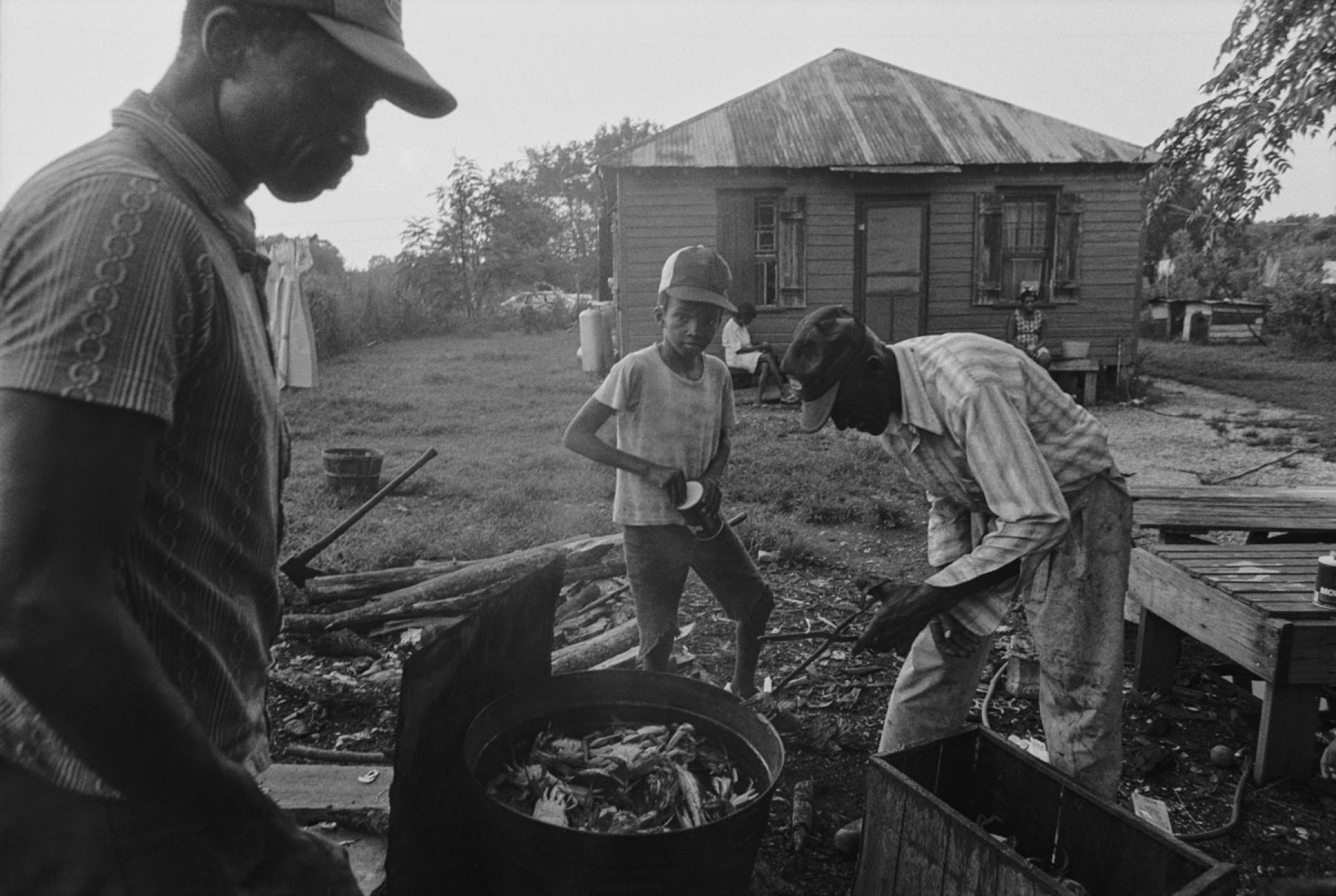Water Is Life
Black coastal Georgians remain resilient in the face of environmental peril
By Neesha Powell-Ingabire

Nichol Young crabs in Brunswick, Georgia's Marshes of Glynn Overlook Park.
After eight years of partnership, I finally showed my spouse, Aimée-Josiane, where I was born and raised: a southeastern pocket of Georgia by the Atlantic, Glynn County, home to the city of Brunswick on the mainland and St. Simons, Jekyll, and a few other small barrier islands. It’s a five-hour drive from our home in Atlanta. High on our list of sights to see was St. Simons Pier Village, a tourist’s dream crowded with shops, restaurants, a park, a lighthouse, and a pier that juts out into the St. Simons Sound.
It was right before the pandemic began, so we inhaled the fishy sea air unobstructed. We smiled at a girl taking pictures in a pink quinceañera dress with young men wearing festive suits. We walked through Neptune Park, named after Neptune Small, an enslaved African who retrieved his master’s corpse from the Civil War battlefield in Fredericksburg, Virginia, accompanying the casket all the way back to St. Simons. I pointed out indigenous live oak trees, sprawling beauties dripping with Spanish moss, regaling Aimée-Josiane with the story of how I almost got my first kiss in one of them.
We walked down a set of stairs to the sliver of sand and shoreline on the other side of the “Johnson Rocks,” a wall of large granite boulders built to prevent erosion, named after the president who initiated their construction, Lyndon B. Johnson. We snapped pictures of each other for the ’gram, then walked west toward the pier. As we walked, I saw a giant ship turned on its side in the water less than a mile away from the pier.
“That’s the Golden Ray,” I told my spouse. I’d heard on the news that in the wee hours of September 8, 2019, the six-hundred-fifty-six-foot-long Hyundai cargo ship capsized in the St. Simons Sound with four thousand two hundred cars, twenty-four crewmen, and four hundred thousand gallons of oil onboard as it departed from the Port of Brunswick. All the crewmen were saved, but nearly two years later, the Golden Ray still sits in the sound, slowly being dismantled section by section under the direction of a Unified Command, which consists of the U.S. Coast Guard, the Georgia Environmental Protection Division, and Gallagher Marine Systems. The Unified Command is responsible for ensuring the wreckage removal abides by environmental protection standards set by the federal Oil Pollution Act of 1990.
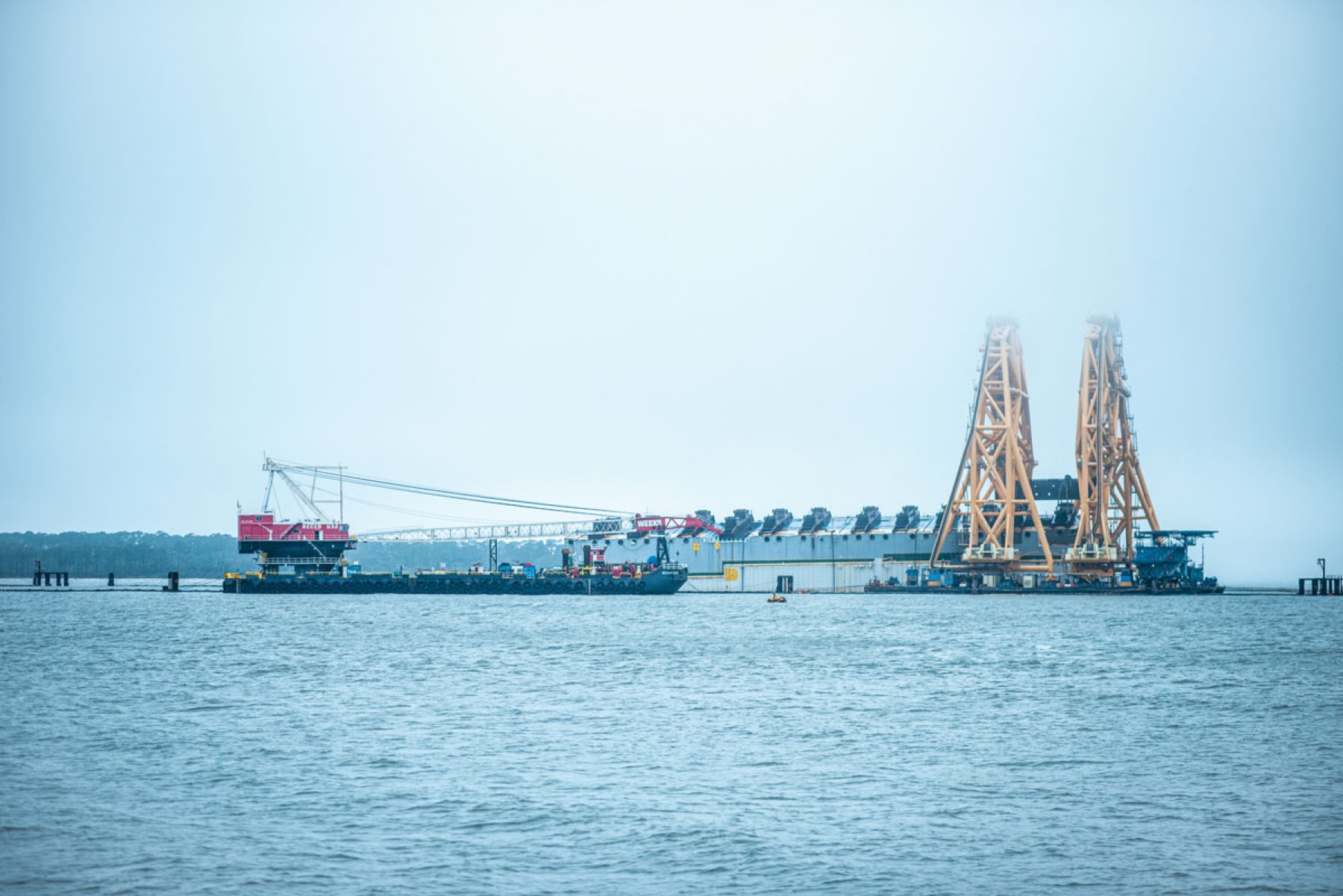
In September 2019, the Golden Ray cargo ship capsized in the St. Simons Sound with more than four thousand cars, twenty-four crewmen, and four hundred thousand gallons of oil onboard. All the crew survived, but the capsized vessel still sits in the sound, slowly being dismantled. Groups including the U.S. Coast Guard are responsible for ensuring the wreckage removal abides by federal oil pollution regulations.
Because Brunswick houses a cluster of factories whose emissions smell and are visible in the air, I always figured we had a pollution problem. But I never considered the possibility of toxins in our water until a few years ago while researching my hometown’s environmental history for an article. The founder of Glynn Environmental Coalition (GEC), Daniel Parshley, told me about his nonprofit’s Safe Seafood Program, which aims to educate fishers in Glynn through direct outreach on how to reduce health risks when eating potentially contaminated local seafood.
Some of my favorite childhood memories involve stuffing myself silly with a delectable blend of freshly caught crab and shrimp, sausage, corn on the cob, and potatoes with newspaper covering the table—outside when it was really a party. As I got older, I realized not all Black American families celebrate like this and began piecing together clues that my family’s relationship with water is different from that of Black people raised inland.
The more I learned about the Gullah Geechee culture from various sources, including Julie Dash’s 1991 film Daughters of the Dust and a Gullah Geechee forum organized by writer Aminata Traoré-Morris held last year in Liberty County, Georgia, the more I suspected it applied to my maternal family, who’ve been rooted on the Georgia coast in Chatham, Liberty, and McIntosh counties for as long as we can remember. Coastal Georgia—along with the coastal areas of North Carolina, South Carolina, and Florida—is the home of Gullah Geechee peoples who’ve retained particular West African traditions in insulated communities, hybridizing them with American culture out of necessity. The Gullah live in the Carolinas, while the Geechee reside in Georgia and Florida. Both have their own distinct arts, crafts, foodways, and language. “Gullah Geechee people have had an integral relationship and connection with the ocean for centuries, whether for their own livelihood and sustenance, for transportation, for supplementing their rations issued by plantation masters,” the environmentalist and public historian Hermina Glass-Hill told me. “It is a spiritual connection to the water as well, and of course, there’s this historical remembrance of consciousness of the Middle Passage that they’re deeply connected to.”
In an interview from the African American Fishermen Oral History Project, Gullah Geechee historian Griffin Lotson explained that, in the past, being Geechee wasn’t “cool” or a “good way to get ahead in society.” This may explain why my family disassociated themselves from this identity. We may not call ourselves Geechee, but now that I better understand the term, I see my family in it. I understand the culture to be the self-sufficient, spiritual way of life developed by descendants of enslaved West Africans on the southeastern coast of the U.S.
Most of my relatives who fished to help sustain themselves, a Gullah Geechee tradition, have passed. Fortunately, my mother is still with us, and she shares bits of our Geechee heritage, even if she doesn’t identify them as such. She recalls my grandmother’s special nuggets of wisdom, such as to only eat oysters in months with names that include the letter “r,” and how neighbors regularly supplied her family with seafood for free that they caught on the job. She told me that my own family worked in the seafood industry in McIntosh County, where they got work at docks “heading” (removing the head from) shrimp and also at a seafood processing plant. My mother laments that her grandmother wouldn’t allow her to head shrimps with her brother and mother.
Exactly a year after first seeing the Golden Ray’s wreckage with my spouse, I returned to Glynn to explore how water pollution affects African-American and Geechee fishing culture in the county. The trip was part of my ongoing quest to reclaim a culture that society has attempted to erase. My itinerary over that Valentine’s Day weekend: shadowing safe seafood outreach to subsistence fishers with Aaron Bell from GEC and collaborating with photographer Keamber Pearson. In addition to learning about and witnessing the polluted waterways, I also hoped to visit Igbo (or Ebo) Landing, a site on St. Simons’s Dunbar Creek where more than a dozen Igbo people from what is now Nigeria drowned themselves rather than be enslaved in May 1803.
It wasn’t until college that I’d come across the story of the “Flying Africans,” the mythologized version of the story. According to an oral history collected in the 1930s from an old Black man named Wallace Quarterman by the Federal Writers’ Project, after being brutally whipped by an overseer, a group of enslaved Africans “got together and stuck that hoe in the field and then . . . rose up in the sky and turned themselves into buzzards and flew right back to Africa.” My wife and I scouted out the location a few hours before Pearson’s flight came in. It was a drizzly Friday evening. My GPS led us to a cul-de-sac, where we were met by a white girl of about ten sitting on a bike with a cat in her arms. My eyes darted from the girl and her cat to the palatial homes shaded by live oaks to a large rusty gate. Seeing no apparent sign of Igbo Landing, we drove away.
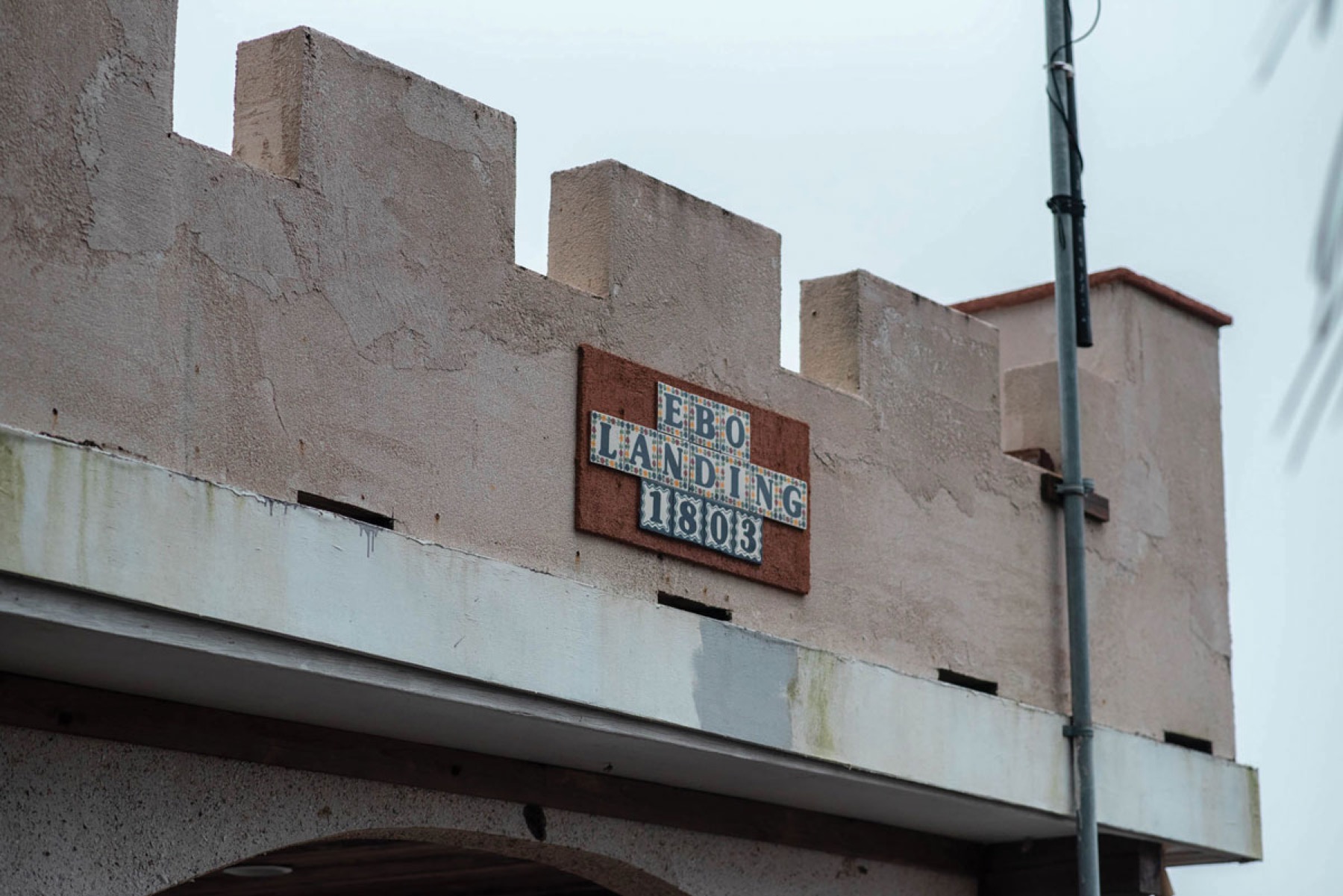
Ebo Landing on Dunbar Creek is where more than a dozen Igbo people from what is now Nigeria drowned themselves rather than be enslaved in May 1803. The creek is now full of sewage from a wastewater treatment plant.
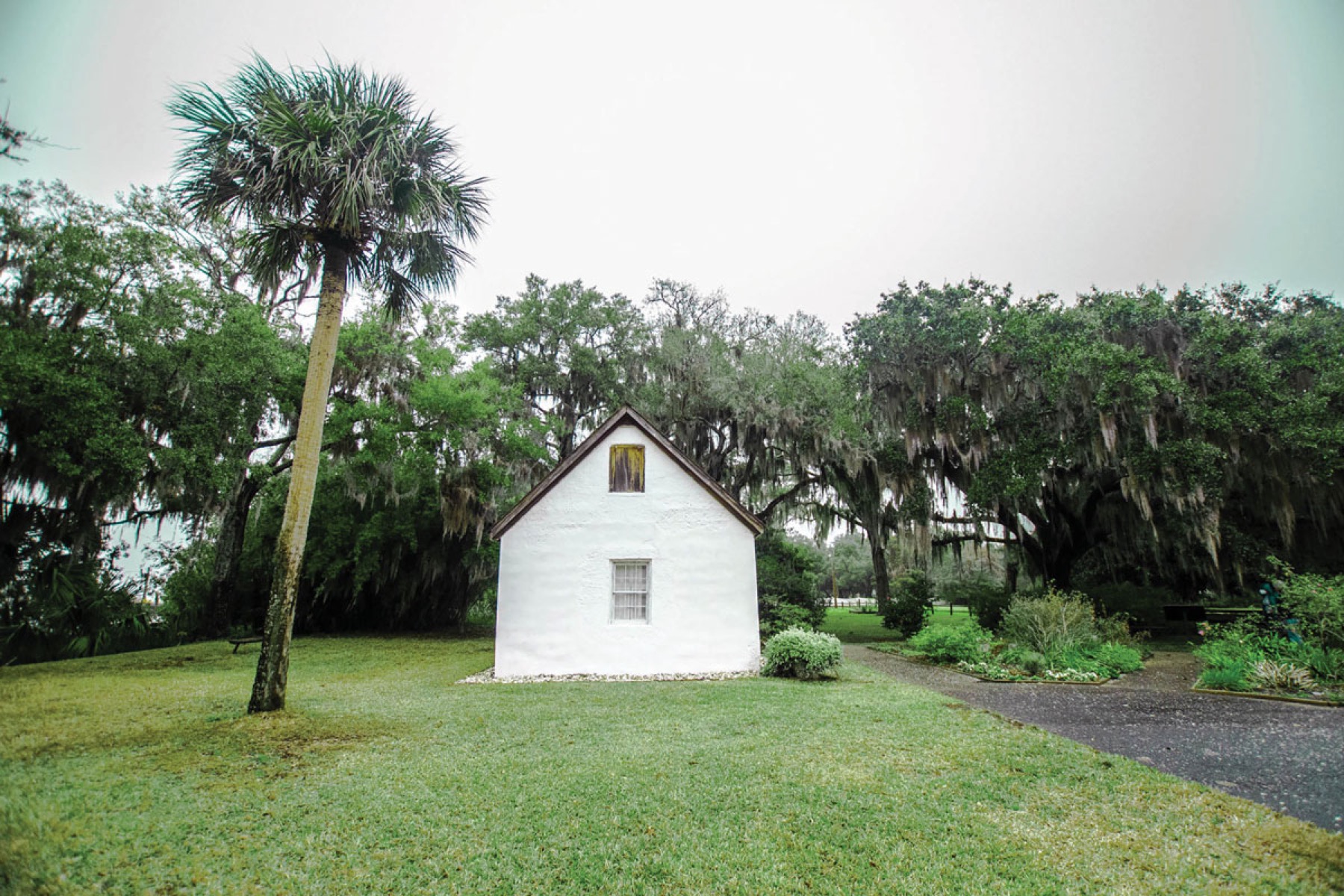
Predominately white preservationist group Cassina Garden Club led restoration of two surviving slave cabins originally built before 1833 as part of Hamilton Plantation. Cabins were made out of tabby—a mixture of crushed oyster shells, lime, salt, and water—and thought to be based on West African building techniques.
The next morning, I drove from my St. Simons hotel across the four-mile causeway to Sidney Lanier Bridge Park in Brunswick to meet Bell, GEC’s Safe Seafood Outreach coordinator. The weather was gray but clear. I donned a Columbia jacket with a hood for the cold weather and possible rain, waterproof Keds, and a KN95 coupled with a cloth mask.
Prior to my trip, Bell told me that African Americans compose the majority of subsistence fishers in the area. Fishing for Food, a research institute at Duke University, broadly defines a subsistence fisher as someone who depends on fish for survival; is low-income; lives close to the body of water where they fish; harvests fish to eat or sell to meet basic food requirements; uses low-technology gear as part of cultural practice; and/or relies on their harvest to meet their nutritional needs.
I could see there wasn’t much activity in the park aside from a few people launching their boats into the Brunswick River. The river is part of the Turtle-Brunswick River estuary, home to the LCP Chemicals Superfund site, which consists of eight hundred thirteen acres of soil, groundwater, surface waters, and marshes that were contaminated by four different industries between the 1920s and 1994. Brunswick boasts a total of four Superfund sites, which have been designated for cleanup by the Environmental Protection Agency as the most hazardous sites in the country, and fourteen sites listed on Georgia’s Hazardous Site Inventory. All but one of the hazardous sites in the small city, which is 55.1 percent Black, lies within a one-mile radius of a “majority-minority” population. Alternatively, predominantly white St. Simons has zero Superfund sites.
Among other substances, the LCP Chemicals site contains mercury and polychlorinated biphenyls (PCBs), which primarily affect people with uteruses of childbearing age, children, and fetuses. They may cause lower IQs, a weakened immune system, and behavioral and psychological effects in children, and may cause thinning of the uterus lining, possibly leading to the need for its removal. Upon studying the rates of hysterectomies in Brunswick, GEC’s founder discovered that he could correlate the rate of hysterectomies in the city to a population that has been heavily exposed to PCBs. In 2012, he assisted the Agency for Toxic Substances and Disease Registry (ATSDR) with testing the blood of nine residents in Sapelo Island, twenty-five miles away from LCP Chemicals, who eat at least two meals of seafood a day. The study measured higher-than-normal levels of PCBs in their blood. These findings cause me to wonder whether these toxins had any bearing on excruciatingly painful periods that took me years to alleviate with an IUD and natural remedies.
A white man who graduated from my rival high school, Glynn Academy, a few years before I graduated from Brunswick High in the mid-2000s, Bell admits that some fishers may be loath to speak with him because he “looks like a cop.” He showed me the handouts he distributes to fishers, a general brochure about fish you can catch and eat in Glynn County, another for people who are pregnant, planning to be pregnant, or nursing a child. The handouts display information on how to minimize risk by limiting consumption of certain seafood and using particular cleaning and cooking methods.
After about thirty minutes of waiting for fishers, we decided to move to another location. Bell said there would’ve been more fishers out if the weather were better. I followed Bell to Marshes of Glynn Overlook Park on the south end of Brunswick, where my tenth-grade boyfriend once took me crabbing. The park is a front-row seat to the “league and a league of marsh-grass, waist-high, broad in the blade” made famous by Confederate army veteran and poet Sidney Lanier (the bridge’s namesake). It sits alongside the Mackay River, which is connected to Terry and Dupree creeks, home to the Terry Creek Superfund site where a manufacturer called Hercules specializing in extracting resins from pine stumps dumped toxaphene waste from 1948 to 1980. Banned in 1990, toxaphene was once a popular pesticide. The ATSDR reports convulsions and damage to the kidneys and liver in humans who have had significant exposure to toxaphene.
At Overlook Park, we spotted a Black man and woman fishing together. They sat in a red SUV to keep warm, getting out to check their net on the dock every so often. Aaron and I approached their car and found out they were from Kingsland, about forty miles south of Brunswick. They were crabbing that day, had never heard about the seafood advisory, and wanted to know more. They asked about who conducted the research (GEC, the Glynn County Health Department, the Georgia Department of Public Health, the Georgia Department of Natural Resources, Sea Grant, and the University of Georgia) and where to find a safer place to crab. Bell suggested spots along the causeway to St. Simons with more inflow and outflow of fresh, clean water.
He also directed the pair’s attention to billowing clouds of white smoke spouting out of a factory about a mile away as the culprit for the toxins. The factory is now known as Pinova; the site was purchased from the Hercules plant's parent company in 2010 and has changed hands a couple of times since. While Pinova rebranded itself as “sustainable” and doesn’t dump hazardous waste, the company is still deemed a co-owner of a hazardous waste facility by the Georgia Environmental Protection Division (EPD). Pinova received Air Quality Act violations in 2016 and 2018 and is currently being investigated by the Georgia EPD and GEC for possibly contributing to a rotting garbage odor that frequently pervades downtown Brunswick. Bell never told the couple not to eat the crab they caught in the advisory area that day. His organization believes that an advisory isn’t going to stop people from fishing in a particular body of water, especially those who fish as a cultural practice. Glynn’s local waterways are as important of a resource as ever—since the pandemic started, GEC has observed an increase in local fishing activity.
During a Zoom interview, GEC’s executive director, Rachael Thompson, told me that some people become alarmed when they learn the nonprofit doesn’t tell people not to eat the seafood in advisory areas, except for when an area is actually in and not just adjacent to a Superfund site.
“We teach people how to mitigate their risk. Our job is not to tell people what to do. Our job is to provide information for people to make decisions about their health,” said Thompson, a young white woman wearing her brown hair on top of her head, dangly earrings, and large glasses. Her voice conveyed an earnest authority. “We’re not a doctor. We’re not PhD scientists over here. We have information that we think will help people make choices. . . . We don’t want people to have these health impacts, but we also understand that for these subsistence fishermen and their families, this might be one of their very limited food sources. We don’t want to exacerbate the food insecurity that already exists in this town.”
At a fishing spot on Dupree Creek, Bell and I met two other crab fishers, one of them a Black male elder with a gray beard named Jimmy. He wore a dark work jumpsuit layered over a hoodie on his small frame and a baseball cap. His wife sat waiting in their car. Despite Jimmy’s bucket full of blue crab, he told us he catches and cooks them for his wife and children, not himself. The other fisher, an amiable, stocky middle-aged white man, wasn’t faring as well as Jimmy and asked for his technique. He told us he was a member of the Coast Guard, originally from Seattle, and living temporarily in St. Simons to help remove the Golden Ray.
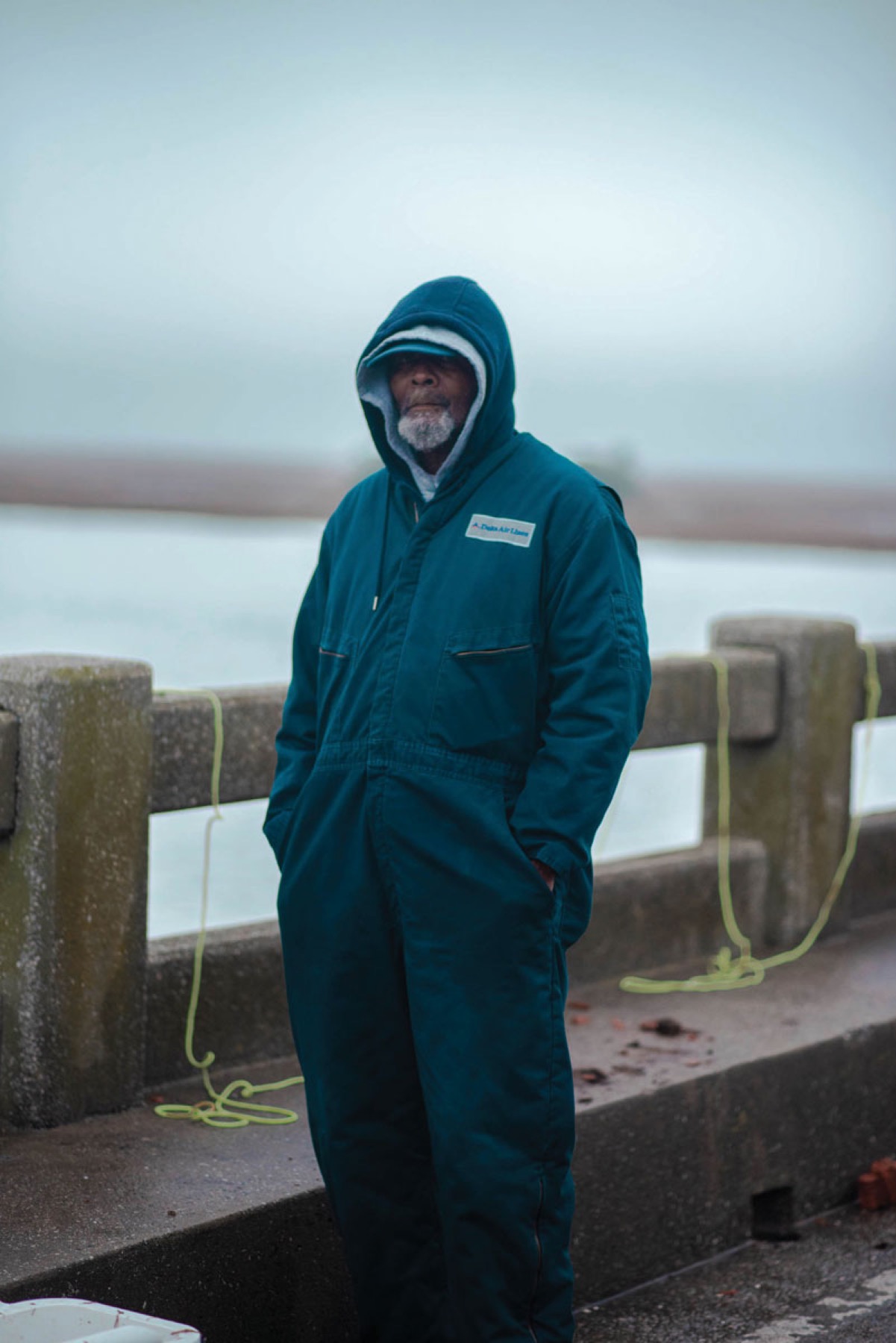
Jimmy stands on a pier along Dupree Creek. As part of safe seafood outreach, GEC advises limiting consumption of certain seafood and using particular cleaning and cooking methods.
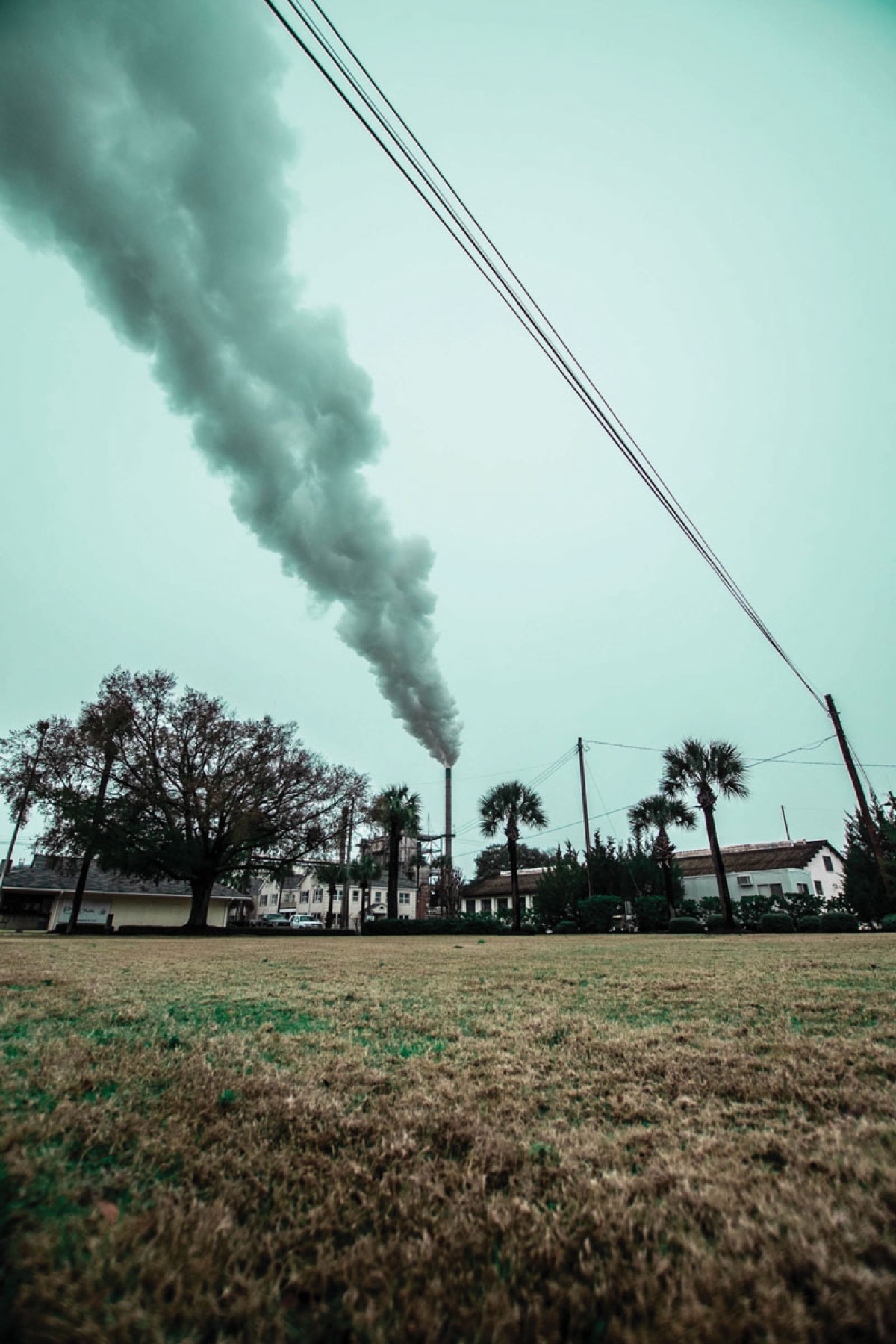
The Hercules company, known for manufacturing an array of chemically toxic products from pine stumps including the now-banned pesticide toxaphene, sold its Brunswick facility to a Canadian private equity firm, which renamed the operation Pinova. Though Pinova doesn’t dump hazardous waste, “related wastes” from the prior operation “ended up in a local landfill, in the soil beneath the facility itself, and in a nearby creek that empties into an important estuary,” says a report in the Guardian.
After visiting a few more fishing spots along the causeway, I followed Bell’s truck to the St. Simons Pier, where we examined the 71,000-ton ship and the VB-10,000, a giant yellow heavy-lift barge tasked with cutting and then transporting ship debris to a recycling facility. I couldn’t help but feel tiny in comparison to this disaster scene. I watched two bottlenose dolphins swimming in unison, unfazed by the wreckage removal. Adults and children on the pier pointed at the animals and shouted with glee. I convinced myself that the two dolphins were a mother and child pair, two beings remaining resilient in the face of environmental degradation—a reflection of Black coastal Georgians.
Fletcher Sams, executive director of the Altamaha Riverkeeper, told me in a post-trip interview that the Golden Ray wreckage removal is shaping up to be one of the most expensive in U.S. history. His nonprofit monitors the vessel’s environmental impacts. Sams said, “Since the morning of day one, we have been documenting damage done to the sound and the estuary. That could be anything, from collecting samples to mapping to documenting the location and times of shoreline impact to helping the Unified Command improve their mitigation strategy.”
There have been several releases of heavy fuel oil, a substance capable of causing cancer in living tissue, from the Golden Ray during the removal process, posing harm to both animals and humans who eat seafood caught in the sound. Sams told me he’s disappointed the state has yet to conduct a Natural Resource Damage Assessment to quantify the ecological and economic harm caused by the shipwreck and formulate recommendations in an effort to reverse damages.
After leaving Bell and the mama and baby dolphin at the pier, Pearson and I met up with my spouse, and the three of us went looking again for Igbo Landing. The night before, a Twitter friend advised that they’d been able to see the approximate location of Igbo Landing from the Dunbar Creek Bridge. We parked at one end of the bridge and walked onto it to get a good view of the creek as cars whizzed by. I wondered what passersby were thinking as we, three Black non-men, walked on the bridge with such purpose in our steps and if they even knew the significance of Dunbar Creek.
We climbed over traffic cones to stand on a thin steel railing right on top of the winding creek. My spouse and I clasped hands, spoke to our ancestors, then dropped an offering of an orange into the water below. I envisioned it hitting the bottom of the creek, where the Igbo rebels’ bodies once lay. Later that day, I found out the sacred creek is now full of sewage from a wastewater treatment plant, an indication of the destruction of coastal Georgia waters that sustain the bodies and spirits of Black people.
Water pollution is an affront to the Gullah Geechee way of life. Despite myriad structural obstacles, African Americans on St. Simons are fighting to preserve their ancestors’ ways of life and connectedness to land and water. In the early 2000s, the St. Simons African American Heritage Coalition, a group of Black residents on the island, and the St. Simons Land Trust saved the Historic Harrington School from demolition by speculative developers. The building housed a grade school for Black children from the 1920s until they began getting bussed to the mainland in the 1950s and then a daycare center until 1970. The Library of Congress contains folk songs by the Georgia Sea Island Singers recorded at the schoolhouse in 1959 by the ethnomusicologist Alan Lomax. A white-washed clapboard building with a brick foundation and chimney, a deep roof overhang, and an adorable replica of the school out front doubling as a Little Free Library, the schoolhouse is a picturesque portal to the Harrington community’s Gullah Geechee past. African Americans once owned eighty-six percent and populated seventy-five percent of the island but have been plagued with what journalist Patrik Jonsson calls a “tropical form of gentrification”: The 2010 U.S. Census reported the island’s Black population as 2.6 percent, and the median home cost on the island today is $378,700.
Driving through the neighborhood, you would never know the private event venue at Village Creek owned by a white family was once the location of a fish camp operated by legendary Geechee fisherman Cusie Sullivan until the 1960s. Born in 1896, he worked as a fishing guide, and rented and sold equipment and refreshments to local fishermen. Author Jingle Davis writes of Sullivan in her book, Island Time, “He knew where and when the fish were biting, what bait to use, how deep to fish, and whether high or low ebb would yield a mess of speckled trout or spottail bass.”
Helen Ladson, tour guide at the Historic Harrington School, told me about what Sullivan meant to his community via email: “Fishing was a source of life in many ways on the coast. On St. Simons Island, Mr. Cusie Sullivan owned one of the most popular fishing camps, now known as Village Creek. This fishing camp served as a source of income to sustain life on the island for the Harrington community. Mr. Sullivan and crew would take visitors out on the marsh to the best fishing sites. Fishing was also a source of protein that was served during mealtime. Fish was prepared in multiple ways: smoked, fried, grilled, baked, or blackened. Fish and grits, shrimp and grits, & crab boil were other delicacies that were and still are consumed.”
Glass-Hill pointed out to me how African Americans have been edged out of coastal Georgia’s commercial fishing industry. “They were fishermen and oyster men and did all kinds of jobs on the ocean. That kind of livelihood has become so commercialized. It’s really hard to compete and get a profit when you’re competing against such large commercial fishing industries,” she said. Dr. Dionne Hoskins-Brown, founder of the African American Fishermen Oral History Project, attributes the decline of Black fishermen in coastal Georgia to increased fishing costs, little access to capital, and a reluctance to have children work in labor-intensive fisheries professions.
I have faith that Gullah Geechee fishing culture isn’t going anywhere as long as Gullah Geechee peoples live, breathe, and eat. A month after my recent trip to Glynn, I met Queen Quet, Chieftess and Head-of-State of the Gullah/Geechee Nation, at the virtual Coastal Cultures Conference (it’s usually held on St. Helena Island, South Carolina, Queen Quet’s home). Eleven years ago, Queen Quet helped found the Gullah/Geechee Fishing Association, which advocates for the indigenous fishing rights of Gullah Geechee and African-American fishers and fishery workers in the southeast. They organize against environmental threats to Gullah Geechee fishing culture, such as flooding and offshore drilling. At the conference, we watched a clip from Gwine Fishin’, a documentary compiled by the Nation over twenty years that tells the plight of Gullah Geechee fishers in South Carolina, who are targeted by the Department of Natural Resources with exorbitant fines for simply “fishing while Black.” The association is fighting for a subsistence fishing bill in South Carolina.
I’d read about Queen Quet in the media for years, so I felt excited and nervous in her virtual presence. A Black woman whose looks are indeed regal, she presided over the conference with shells in her twisted hair. She switched effortlessly between using the Gullah language and the Queen’s English, drawing from ancestral and spiritual knowledge, and her mathematics and computer science background, too. She made sure we knew that we were in a sacred space. Her disappointment with the media’s typical portrayal of her culture stuck with me. She mentioned recent coverage by journalist Soledad O’Brien and model and food show host Padma Lakshmi that focused on the disappearance of Gullah Geechee culture instead of its preservation and the ways in which it is still flourishing.
Before the conference adjourned, each attendee shared a little about ourselves. After I spoke about how I haven’t historically claimed Geechee despite my suspected Geechee heritage, Queen Quet said, “You may not claim us, but we’re still going to claim you.” A fellow attendee chimed in, saying she once stood in my shoes. “After you begin identifying as Geechee, the rest of your family will follow,” she advised. Exiting out of Zoom, I felt like Sethe in Beloved, when Paul D tells her she is her best thing. I felt like I was enough. Queen Quet affirmed that it was okay to claim Geechee without my family’s permission. So now I wonder if my Geechee ancestors wail each time their precious waters are desecrated.
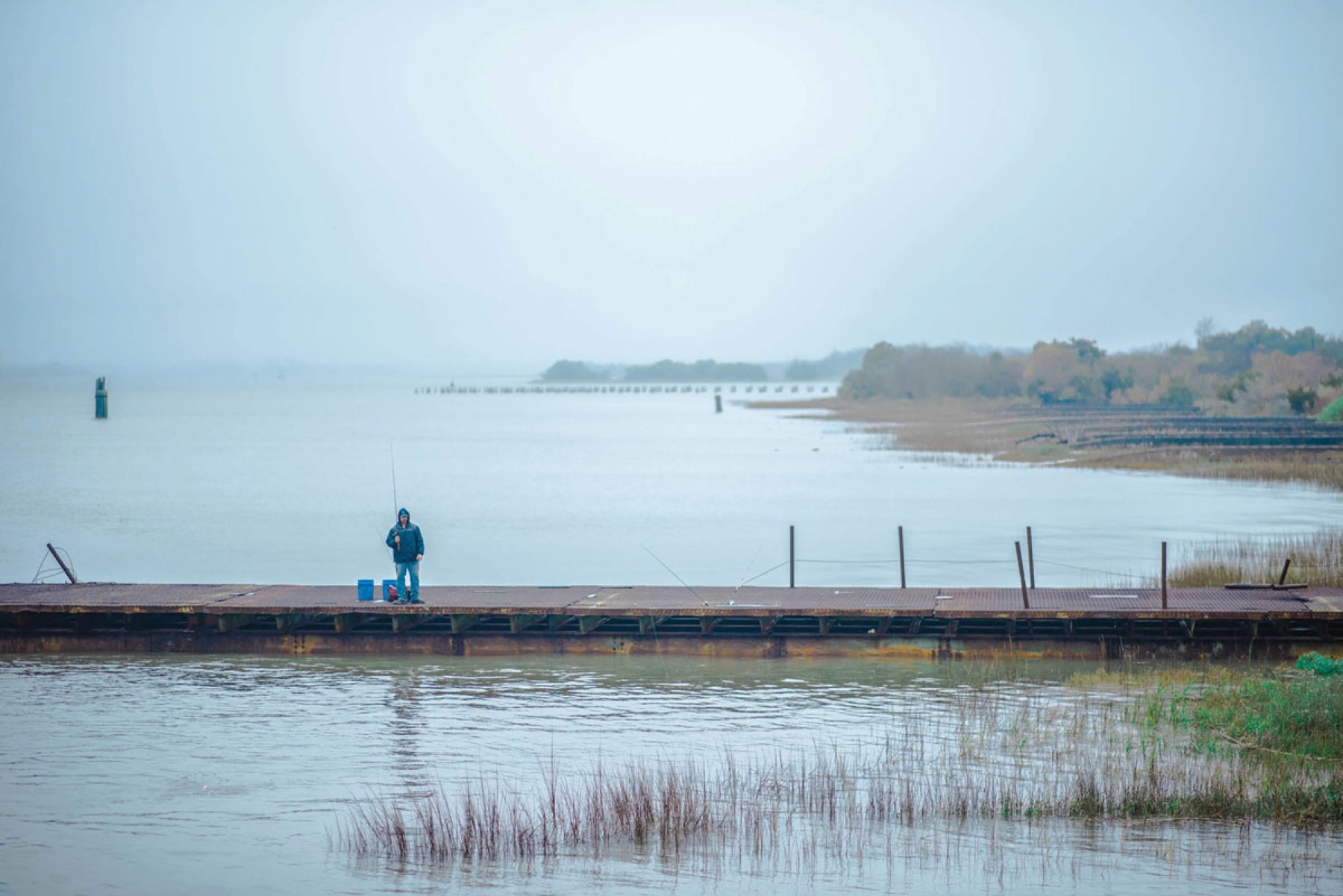
Someone fishes on the dock at the Sidney Lanier Bridge Park. Glynn’s local waterways are as important of a resource as ever, according to GEC.



